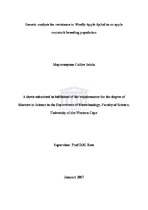| dc.description.abstract | Genetic analysis for resistance to Woolly Apple Aphid in apple rootstock breeding populations MC Selala MSc Thesis, Department of Biotechnology, Faculty of Science, University of the WesternCape. The Woolly Apple Aphid (WAA) Eriosoma lanigerum (Hausm.) (Homoptera: Aphididae) is economically one of the most important pests in apple commercial production in the Western Cape province, South Africa. The apple cultivar Northern Spy possesses a single major gene (Er1) responsible for E. lanigerum resistance. This cultivar has been used as a commercial rootstock in apple breeding programmes. There are other genes also implicated in resistance to E. lanigerum from other cultivars. Manipulation and pyramiding of the E. lanigerum
resistance genes (Er1, Er2 and Er3) might provide a necessary control for commercial apple production. The aim of this study was to construct a genetic linkage map for apple using
microsatellite markers. The use of marker-assisted selection would greatly benefit local apple breeding programmes. Ninety six seedlings from a Northern Spy × Cox Orange Pippin mapping population were used for genetic linkage construction. Phenotypic data collection and analysis were performed to determine the E. lanigerum infestation patterns and the levels of resistance conferred by the Er1 gene from Northern Spy using 52 in vitro propagated seedlings in the greenhouse. Classification and quantification analysis showed association patterns between first assessments (30 days) to second assessment (60 days) in all replicate blocks. Roots and shoots data showed that it could be useful in quantitative trait loci (QTL) analysis, but may be used in different QTLs beingidentified due to the variations between roots and shoots data. A preliminary linkage map was constructed using a mapping population from Northern Spy × Cox Orange Pippin (96 seedlings).Fluorescently labelled published and predicted
microsatellite markers were used in map construction. Primers were optimised using single apple cultivar and the detection of polymorphisms using nine apple cultivars. Optimised markers were multiplexed for high throughput data generation using the Polymerase Chain Reaction (PCR) technique. Multiplexed PCR products were pooled and analysed on an ABI 310 PRISM™ Genetic Analyser to determine allele fragment sizes, and the inherited segregation types in the seedlings. Computer software GenoTyper® 2.5.2 and JoinMap® 3.0 was used in data analysis from ABI 310 PRISM™Genetic Analyser and linkage map
construction. Seventy two markers were used in linkage map construction, which produced nine linkage groups with some segments from the same linkage group. Twenty-one markers were aligned on the map 20 published and one predicted. Only one linkage group consisted of five markers while other linkage groups had two markers each. This study has proved that th preliminary linkage map could be used as the basis of a complete linkage map of Northern Spy × Cox Orange Pippin. | en_US |

